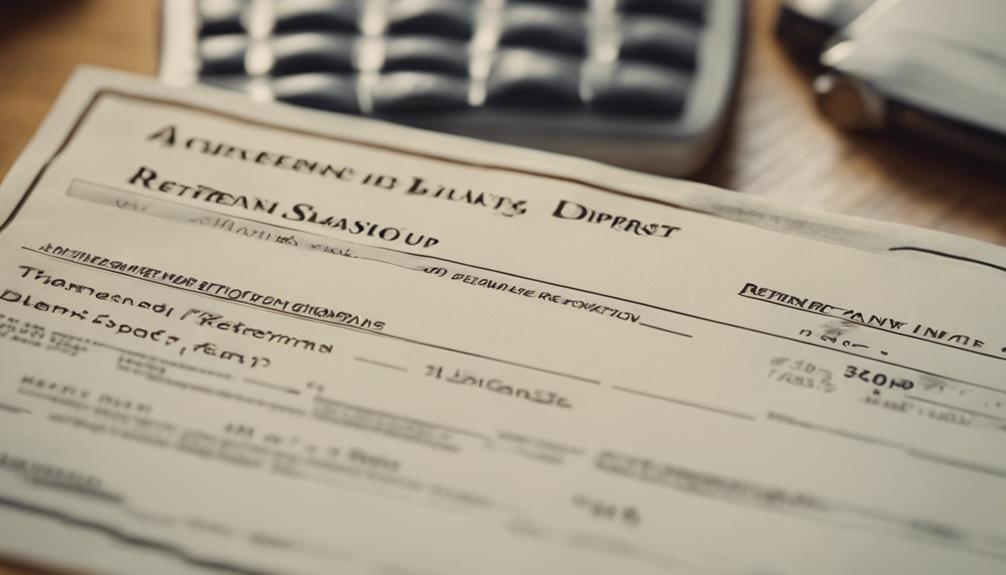Retirement plans generate income through strategic contributions and investments. Regular contributions, made by both employees and employers, are invested pre-tax to maximize growth. Diversification of investments across different asset classes helps to manage risk, while compounded effects lead to long-term earnings. Asset allocation strategies take into account risk tolerance and goals, adjusting based on market trends. Effective risk management techniques such as regular rebalancing and diversification protect investments. Monitoring portfolio performance, managing fees, and understanding payout options are crucial for maintaining retirement income. By adhering to these principles and staying informed, you can improve your comprehension of retirement plan earnings.
Key Takeaways
- Contributions from employees and employers generate funds.
- Employer contributions enhance growth potential.
- Strategic investment and asset allocation maximize earnings.
- Compounding effect boosts long-term growth.
- Diversification across asset classes spreads risk and increases returns.
Contribution Structure

How is the contribution structure of retirement plans designed to facilitate the growth of assets over time?
Retirement plans rely on contributions from employees, often matched by employers, to build a fund for the future. These contributions are deducted from employees' salaries before taxes, reducing their current taxable income. Employer contributions, if available, can greatly enhance the growth potential of the retirement plan.
The money contributed to these plans is then strategically invested across various asset classes such as stocks, bonds, and mutual funds. By diversifying the investments, the plan aims to generate returns over time.
The compounding effect comes into play as the contributions, combined with the investment returns, continue to grow the retirement assets. This compounding effect is essential for long-term growth, as it allows both the initial contributions and the returns on those contributions to further generate earnings, ultimately helping individuals build a substantial retirement nest egg.
Investment Portfolio Diversification

Diversification in investment portfolios involves spreading funds across different asset classes to manage risk effectively. By diversifying, retirement plans can minimize the impact of market volatility on their overall performance.
This strategy aims to capture returns from various sectors of the economy while balancing risk and return to optimize long-term growth.
Asset Allocation Strategies
Strategically diversifying investments across various asset classes is a fundamental approach in managing risk and optimizing returns within retirement plans. Proper asset allocation strategies consider an individual's risk tolerance and investment goals to create a balanced investment portfolio.
Strategic asset allocation involves setting long-term objectives, considering the time horizon and market conditions. On the other hand, tactical asset allocation adjusts allocations based on short-term market trends to capitalize on potential gains.
Periodically rebalancing the portfolio is crucial to make sure that the asset allocation aligns with the investor's risk tolerance and financial objectives. By following these asset allocation strategies, investors can work towards maximizing returns while minimizing volatility, ultimately aiding in achieving their retirement goals.
Risk Management Techniques
Effective risk management in investment portfolios hinges on the strategic allocation of assets across various classes to mitigate potential losses and optimize returns.
- Asset Allocation: Allocate funds across different asset classes like stocks, bonds, real estate, and commodities.
- Risk Tolerance Assessment: Evaluate individual risk tolerance to determine suitable investments.
- Regular Rebalancing: Periodically review and adjust the portfolio to maintain diversification.
- Consider Employee Contributions: Factor in employee contributions when diversifying retirement plans.
- Review Specific Investments: Regularly assess specific investments to make sure they align with the overall diversification strategy.
Portfolio Performance Analysis
In evaluating the performance of an investment portfolio, a thorough analysis of its composition and distribution across various assets is vital for optimizing growth potential and managing risk effectively. Diversifying investment portfolios through asset allocation helps reduce risk by spreading investments across different types, such as stocks, bonds, and real estate.
Portfolio performance analysis within retirement plans involves evaluating the returns and risks of individual investments to maximize growth potential aligned with retirement objectives. Regular monitoring is essential to adjust investments in response to market changes, ensuring continued progress towards long-term investment growth.
Strategic asset allocation plays a significant role in balancing risk and reward, tailoring the investment mix to individual goals and risk tolerance levels. Investment portfolio diversification remains key to managing risk and achieving sustained growth, safeguarding against market volatility to secure overall returns.
Asset Allocation Strategies

When planning for retirement, selecting the appropriate asset allocation strategy is essential. Diversification across various asset classes like stocks, bonds, and real estate can help manage risk and potentially increase returns.
Rebalancing your portfolio periodically guarantees that your investments align with your goals and the ever-changing market conditions.
Diversification for Growth
Diversification for growth in retirement plans involves strategically allocating investments across various asset classes such as stocks, bonds, and real estate to minimize risk and maximize long-term growth potential.
- Mitigating Risk: Spreading investments reduces vulnerability to market fluctuations.
- Maximizing Growth: A strategic mix of assets based on risk tolerance boosts growth potential.
- Periodic Rebalancing: Ensuring alignment with goals and market conditions maintains effectiveness.
- Long-Term Opportunities: Proper diversification safeguards savings during downturns.
- Enhanced Performance: Well-diversified portfolios tend to deliver more stable returns over time.
Risk Management Techniques
Effective asset allocation strategies are pivotal in safeguarding investments and optimizing returns while managing risk within retirement plans. Asset allocation involves dividing investments among different asset classes like stocks, bonds, and cash equivalents to reduce overall risk.
Diversification within these asset classes further spreads risk by investing across various sectors and industries. Rebalancing, a key component of asset allocation, guarantees that the portfolio maintains the desired mix by selling high-performing assets to purchase underperforming ones.
Factors such as risk tolerance, time horizon, and investment goals are essential in determining the appropriate asset allocation strategy for individuals with defined benefit or defined contribution retirement plans. Utilizing mutual funds or index funds can be beneficial in implementing these asset allocation strategies effectively.
Portfolio Rebalancing Importance
Portfolio rebalancing is crucial for maintaining the desired asset allocation percentages within retirement plans. It helps align investments with the set mix in a retirement plan. Here are some key points highlighting its importance in asset allocation strategies:
- Risk Control: Portfolio rebalancing aids in controlling risk by realigning investments with the investor's goals.
- Volatility Reduction: It prevents overexposure to specific asset classes, thus reducing portfolio volatility.
- Long-Term Returns: Rebalancing enhances long-term returns by capturing gains and minimizing losses.
- Investment Goals: It ensures that the portfolio remains in line with the investor's investment objectives.
- Maintaining Desired Mix: Portfolio rebalancing assists in maintaining the target asset allocation percentages over time.
Market Performance Impact

The performance of financial markets directly influences the returns generated by retirement plans. Market performance, including fluctuations in stock values, bond yields, and fund growth, plays a pivotal role in determining the earnings of retirement portfolios.
Diversification within these portfolios is essential to spread risk across various asset classes, impacting the overall returns earned. By employing strategic investment strategies that consider market conditions, individuals can optimize their retirement savings and potentially increase their earnings over time.
Professional management of retirement accounts, along with proper asset allocation, is key to managing market fluctuations and ensuring consistent growth in earnings. Monitoring the market and adjusting investment strategies accordingly can help mitigate losses and capitalize on opportunities for growth.
Fees and Expenses Management

The management of fees and expenses within retirement plans plays an important role in optimizing returns and controlling costs for both employers and employees. Understanding the various fee structures and expense management strategies is essential for ensuring the long-term financial health of retirement accounts.
- Asset-based fees: These fees are calculated as a percentage of plan assets and cover a range of expenses.
- Flat fees: A set amount charged for plan administration regardless of the assets under management.
- Revenue sharing arrangements: Where fees are shared between employers and employees, impacting the overall cost.
- Transparency: Clear fee disclosure is vital to understanding the impact of fees on investment returns.
- Commission-based compensation: Some service providers may earn fees through commissions, potentially influencing their recommendations.
Risk Management Techniques

One effective approach to enhancing the financial stability of retirement plans is through the implementation of robust risk management techniques. Diversifying investments across various asset classes within a defined contribution plan can help reduce overall risk exposure.
Strategies such as hedging with options or futures contracts can protect retirement assets from market volatility. Utilizing dollar-cost averaging by consistently investing fixed amounts over time can mitigate the impact of market fluctuations.
Regular portfolio rebalancing guarantees that the asset allocation aligns with the investor's risk tolerance and long-term goals. Employing stop-loss orders can limit potential losses by automatically selling an asset if it reaches a predetermined price.
These risk management techniques play an important role in safeguarding retirement funds, especially in tax-deferred growth accounts like target-date funds that offer a mix of investments based on the investor's retirement date. By incorporating these strategies, individuals can better navigate the uncertainties of the market and work towards securing their financial future.
Retirement Benefit Payouts

Facilitating financial security during retirement, benefit payouts from retirement plans are crucial components that rely on the accumulated savings and investment earnings within the account. Retirement benefit payouts are structured in various ways to provide retirees with income during their non-working years.
Here are some key points to keep in mind regarding retirement benefit payouts:
- Payouts are funded by the accumulated savings and investment earnings within the retirement account.
- The sustainability of payouts depends on the performance of investments within the retirement plan.
- Payouts can be received as regular disbursements to provide a steady income stream.
- Alternatively, retirees may opt for lump-sum withdrawals, which provide access to a larger amount of funds at once.
- Choosing an appropriate withdrawal strategy is essential to make sure that retirees can meet their financial needs throughout retirement.
Frequently Asked Questions
Where Does Your Retirement Money Come From?
Your retirement money comes from a combination of sources, including contributions from both you and your employer, as well as any investment gains earned over time.
These funds are typically invested in various financial instruments like stocks, bonds, and mutual funds to generate returns.
How Does a 401K Make Money?
A 401(k) plan generates money through investment growth from employee and potentially employer contributions. These funds are typically diversified across options like mutual funds and stocks to aim for long-term returns.
Compound interest within the account allows for exponential growth as earnings are reinvested. Employer matching contributions can double a portion of the employee's contributions, enhancing wealth accumulation.
Additionally, the tax-deferred nature of 401(k) contributions postpones taxes on earnings until withdrawal, enabling more substantial growth over time.
How Are Retirement Plans Paid?
Retirement plans are typically funded through a combination of contributions from individuals and employers. Individuals can contribute a portion of their earnings to the plan, often with the benefit of tax advantages. Employers may also contribute to the plan on behalf of their employees, sometimes offering matching contributions. The accumulated funds in retirement plans are then invested in various financial instruments, such as stocks, bonds, mutual funds, or other assets, with the goal of growing the savings over time. This is how retirement plans earn money—through the returns generated by these investments. The growth of these savings depends on factors like investment performance, market conditions, and the duration of the investment.
These funds are then invested in various assets, such as stocks, bonds, and mutual funds, to generate returns and grow the overall value of the retirement plan.
How Do You Get Income in Retirement?
In retirement, income is typically sourced from various streams, including savings, investments, pensions, and Social Security benefits. It is crucial to have a diversified portfolio that can provide a steady income flow during retirement.
Managing expenses, creating a budget, and maximizing sources of income are key strategies to guarantee financial stability in retirement. Additionally, considering factors like inflation and healthcare costs can help in planning for a comfortable retirement.
Conclusion
To sum up, the adage 'Don't put all your eggs in one basket' holds true when it comes to retirement planning. By diversifying your investment portfolio, managing fees and expenses, and employing risk management techniques, retirement plans can earn money and provide long-term financial security.
It is important to carefully consider asset allocation strategies and stay informed about market performance to optimize retirement benefit payouts. Remember, a well-balanced approach is key to a successful retirement plan.









